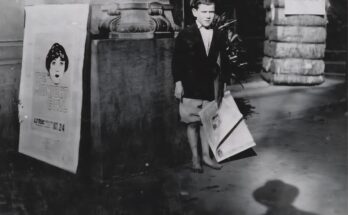In late May 1944, during the height of the mass deportation of Hungarian Jews to Auschwitz II-Birkenau, an SS photographer captured a haunting and deeply poignant moment. Among the horror and despair of the extermination camp, a small act of innocence unfolded—one that would be preserved in a single photograph, frozen in time. In that image, a little child is seen reaching out, holding or showing a dandelion to an older boy. This moment, seemingly ordinary, was filled with the purity of childhood, even in a place where life was about to be extinguished.
The children in the photograph had just endured the brutal journey from Hungary to Auschwitz, crammed into overcrowded cattle cars with little food, water, or air. Upon arrival, families were torn apart during the infamous “selection” process, where SS doctors decided who would live temporarily as forced laborers and who would be sent immediately to the gas chambers. The children in the photo had already passed through this selection. They were among those deemed unfit for work—women, children, the elderly, and the sick—sent to what was called the “undressing area,” just steps from the gas chambers.
The photograph captures them at that liminal, terrifying moment between life and death. Yet the child, unaware of what lay ahead, noticed a simple dandelion in the grass. That gesture—of picking it, of showing it to someone else—was a quiet act of humanity amid inhumanity. It was a moment of connection, of beauty, of innocence surviving against impossible odds. The older boy, to whom the dandelion was being offered or shown, appears calm, perhaps comforting the younger child, or perhaps too exhausted to react.
That dandelion—so delicate, so fleeting—has since become a symbol of what was lost. Every life that passed through Auschwitz had its own story, its own potential, its own loves and dreams. In this case, two children, who should have had entire lives ahead of them, had only minutes or hours remaining. They were likely murdered in a gas chamber shortly after the photo was taken, along with hundreds of others from the same transport. Their names were not recorded. Their identities remain unknown.
The SS photographers, tasked with documenting the operation of the camp for Nazi purposes, inadvertently captured the emotional truths they were attempting to dehumanize. What was meant as a tool of control and evidence for the Nazi regime now stands as silent witness to the lives destroyed. The image of the child with the dandelion survived, while its subjects did not. In doing so, it offers testimony more powerful than words alone could convey.
Eighty-one years later, this photograph remains one of the most heartbreaking visual records of the Holocaust. It reminds us that behind the statistics, behind the millions murdered, there were children who loved flowers, who played, who found wonder in the world—even in its final moments. This child’s gesture with the dandelion was an act of innocence that pierced the machinery of genocide.
We must not look away from such images. They are painful, but they are essential. They remind us of the depth of loss, the scope of cruelty, but also of the dignity and humanity that survived in the smallest of gestures. Remembering the child with the dandelion is a way of saying: your life mattered. You were seen. You are not forgotten.
In that single image, the Holocaust reveals both its monstrous cruelty and its unbearable sorrow. A child holds out a dandelion—and the world is forever changed.


